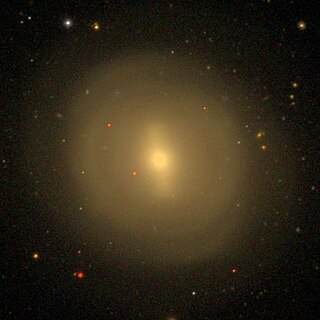
NGC 4477 is a barred lenticular galaxy located about 55 million light-years away in the constellation of Coma Berenices. NGC 4477 is classified as a type 2 Seyfert galaxy. The galaxy was discovered by astronomer William Herschel on April 8, 1784. NGC 4477 is a member of Markarian's Chain which forms part of the larger Virgo Cluster.
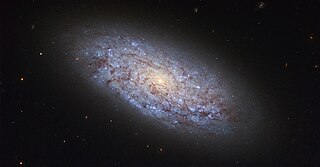
NGC 5949 is a dwarf spiral galaxy located around 44 million light-years away in the constellation Draco. NGC 5949 was discovered in 1801 by William Herschel, and it is 30,000 light-years across. NGC 5949 is not known to have an Active galactic nucleus, and it is not known for much star-formation.

NGC 1019 is a barred spiral galaxy approximately 316 million light-years away from Earth in the constellation of Cetus. It was discovered by French astronomer Édouard Stephan on December 1, 1880 with the 31" reflecting telescope at the Marseille Observatory.

NGC 4540 is a spiral galaxy with type 1 Seyfert activity located about 64 million light-years away in the constellation Coma Berenices. NGC 4540 was discovered by astronomer William Herschel on March 21, 1784 and is a member of the Virgo Cluster.

NGC 521, also occasionally referred to as PGC 5190 or UGC 962, is a barred spiral galaxy located approximately 224 million light-years from the Solar System in the constellation Cetus. It was discovered on 8 October 1785 by astronomer William Herschel.
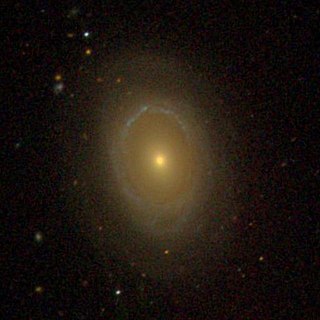
NGC 3884 is a spiral galaxy located about 330 million light-years away in the constellation Leo. The galaxy was discovered by astronomer William Herschel on April 27, 1785 and is a member of the Leo Cluster.

NGC 688 is a barred spiral galaxy with starburst activity located 190 million light-years away in the constellation Triangulum. It was discovered by astronomer Heinrich d'Arrest on September 16, 1865 and is a member of the galaxy cluster Abell 262.
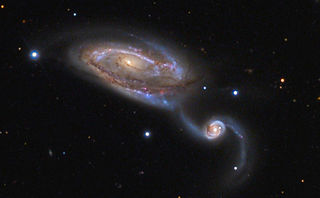
NGC 5395 is an interacting spiral galaxy located at a distance of 160 million light years, but receding away from the Earth at 3511 kilometers per second, in the constellation Canes Venatici. It was discovered by William Herschel on May 16, 1787. NGC 5395 and NGC 5394 are included in the Atlas of Peculiar Galaxies as Arp 84 in the category "Spiral galaxies with large high surface brightness companions".
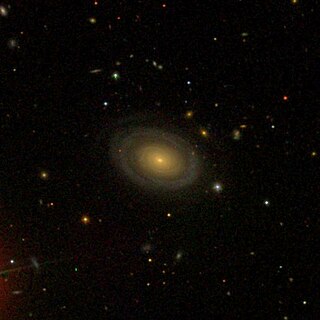
NGC 5790 is a lenticular galaxy located 541 million light-years away in the Boötes constellation. It was discovered on 16 May 1884 by French astronomer Édouard Stephan. The galaxy is approximately 180,000 light-years across. NGC 5790 is a type 2 Seyfert galaxy according to the SIMBAD database.

NGC 2606 is a spiral galaxy in the Ursa Major constellation. It lies 648 million light-years away from our home galaxy, the Milky Way. The galaxy was first discovered by John Herschel, a British astronomer on 16th February 1831. According to SIMBAD database, it is classified as a LINER galaxy and a Seyfert type 2 galaxy by Hyperleda.

LEDA 1245565 is a spiral galaxy located 1.04 billion light-years way in the constellation of Virgo. It has a similar structure as the Milky Way though it has a low black hole mass. It is classified as a Seyfert type 1 galaxy by SIMBAD database.
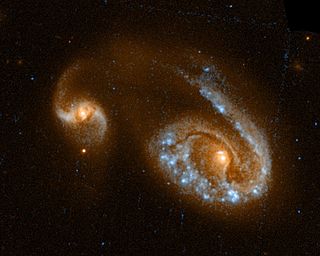
NGC 5278 is a spiral galaxy in the constellation Ursa Major. It was discovered by German-British astronomer William Herschel in 1789. NGC 5278 is in gravitational interaction with the galaxy NGC 5279. This pair of galaxies appears in the Halton Arp's Atlas of Peculiar Galaxies under the symbol Arp 239. The luminosity class of NGC 5278 is II. The nucleus of this galaxy presents a burst of star formation and it is an active Seyfert 2 type galaxy. In addition, NGC 5278 is possibly a LINER galaxy, a galaxy whose nucleus presents an emission spectrum characterized by broad lines of weakly ionized atoms. NGC 5278 is also a galaxy whose core shines in the ultraviolet spectrum. It is listed in the Markarian catalog under the reference Mrk 271.
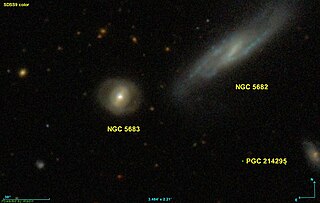
NGC 5683 is a type S0-a lenticular galaxy with a bar located in the Boötes constellation. It is 513 million light-years away from the Solar System and has an approximate diameter of 256,000 light-years meaning it is larger compared to the Milky Way. NGC 5683 was discovered by George Johnstone Stoney on April 13, 1850.

IC 1166 are a pair of galaxies in the Corona Borealis constellation comprising IC 1166 NED01 and IC 1166 NED02. They are located 977 million light-years from the Solar System and were discovered on July 28, 1892, by Stephane Javelle.

NGC 3758 known as the Owl Galaxy, is a type Sb spiral galaxy in the constellation of Leo. It is located 447 million light-years from the Solar System and an approximate diameter of 70,000 light-years. NGC 3758 was discovered by Ralph Copeland on March 18, 1874, but also independently discovered by Edouard Stephan ten years later.
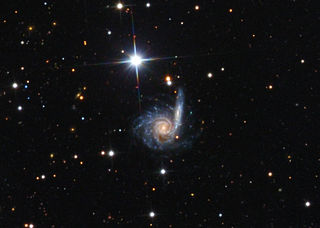
NGC 6365 is a pair of spiral galaxies in the constellation Draco. It consists of two galaxies, PGC 60174 to the south, and PGC 60171 to the north. These two galaxies are also designated respectively by the NASA/IPAC database as NGC 6365A and NGC 6365B. This pair of galaxies was discovered by German astronomer Lewis Swift in 1884.

NGC 1320 is a spiral galaxy located in the constellation Eridanus. Its speed relative to the cosmic microwave background is 2,620 ± 15 km/s, which corresponds to a Hubble distance of 38.6 ± 2.7 Mpc. It was discovered by the German-British astronomer William Herschel in 1784.

NGC 638 is a barred spiral galaxy located in the constellation of Pisces. Its velocity speed to the cosmic microwave background is 2,864± 21 km/s, which corresponds to a Hubble's law of 42.2 ± 3.0 Mpc. NGC 638 was discovered by American astronomer Lewis A. Swift in 1886.

NGC 5508 is a very large and distant spiral galaxy located in the constellation Boötes. Its velocity relative to the cosmic microwave background is 11,615 ± 15 km/s, which corresponds to a Hubble's law of 171 ± 12 Mpc. It was discovered by French astronomer Édouard Stephan in 1882.
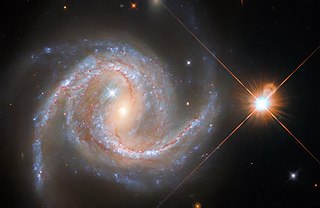
NGC 5495 is a very large barred spiral galaxy located in the constellation Hydra. Its speed relative to the cosmic microwave background is 6,989 ± 20 km/s, which corresponds to a Hubble distance of 103.1 ± 7.2 Mpc. NGC 5495 was discovered by British astronomer John Herschel in 1834.




















